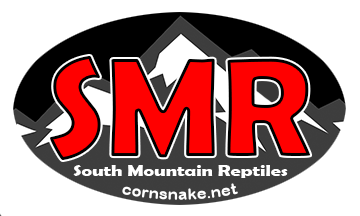Snakes are ectothermic, meaning they cannot create their own body heat. They rely entirely on surrounding temperatures to facilitate essential processes like metabolism and food digestion.
Your snake will often feel cold to your touch (since your skin is around 90f to 95f, but this is normal and does not mean your snake is dangerously cold.
🔥 Setting Up Your Corn Snake's Heating: UT vs. OT
Under Tank (UT) and Over Tank (OT) heating are the most common methods used for corn snake terrariums (or vivaria).
We strongly recommend UT heating (heat mats/pads). This method is the safest and most accurately simulates how corn snakes achieve proper body heat in their natural habitat.
💡 UT Heater Installation and Size
For safe and effective heating, the size and placement of your Under Tank heater are crucial:
Maximum Size: The size of the UT heater should never exceed 1/4 of the length of the cage.
Placement: Affix the UT heater to the underside of the vivarium at one end only. This ensures the snake has a cooler refuge zone if the warm area is too hot.
Tip for Oversized Heaters: If you have a UT heater that is larger than 1/4 of the floor space, place the warm hide so it is only partially over the heating device. If the hide is too warm, the snake will move to cooler zones, which hinders appetite and digestion.
🌡️ Temperature Control With a Pulse Proportion Thermostat (Proportional Control Method)
A pulse proportion thermostat maintains highly stable temperatures by rapidly turning the heating element (like a ceramic heat emitter or heat mat) on and off, adjusting the duration of the "on" time based on the difference between the actual temperature and the set point. This effectively supplies a precise percentage of power needed to maintain the target temperature.
We do not recommend non-proportional thermostats or rheostats for the casual keeper due to potential failure risks.
- Non-proportional devices cause temperature swings spikes of 5f – 7f at the end of each heating cycle, which can cause digestive stress.
- If the heat source is properly sized (less than 1/4 coverage), and the snake has a cool refuge, the system is much safer.
Emily from Snake Discovery made a great video showing the difference in thermostat here
🌡️ Temperature Control Without a Thermostat (Old School Substrate Method)
You can easily adjust your snake's primary temperature zone to achieve ideal appetite and digestion temperatures by simply adjusting the depth of the cage substrate.
| Temperature Check | Action to Take |
| Hide is Too Hot (Over 85f) | Increase the substrate depth (e.g., aspen) to move the snake farther from the heat source under the tank. |
| Hide is Too Cool (In the low 80f) | Decrease the substrate depth to move the warm hide closer to the heat source. |
⚠️ Critical Caution on Heat Mat Selection
It is a common and dangerous misconception that all reptile heat mats (Under Tank Heaters/UTHs) produce the same amount of heat, or that they are self-regulating to a safe temperature. In reality, the maximum unregulated temperature can vary significantly between brands, wattage, and even individual units.
🎯 The Single Heating Goal
The appetite and digestion temperature goal is always to maintain the warm hide between 80f and 85f This goal is only useful if the snake willingly chooses to access that zone.
Note on Joint Use: In rare instances (typically very large enclosures), UT and OT heaters are used together. If this is the case, the same temperature goal and safety principles apply: the snake must be able to escape the heat and access a cool refuge.
⚠️ A Note on Hot Rocks
HOT ROCKS should never be used for any snake. While corn snakes usually avoid them, they are dangerous for many species (like Ball Pythons) and can cause burns. A corn snake avoiding a hot rock may spend too much time in the cooler zone, leading to illness.
The Most Crucial Temperature Zone
Only one temperature matters in the vivarium: the snake’s body temperature.
Because corn snakes are naturally nocturnal and do not require UV light, the only place you need to control the heat is inside the warm hide.
- Ideal Hide Temperature Range: Continually between 80F and 85F
-
Recommended Set Point: 81F to 84F
Why Over Tank (OT) Heating is Impractical
OT heating (lamps or heat emitters) is often inefficient and inherently unsafe for nocturnal corn snakes in a converted enclosure:
- Inefficiency: Hot air rises, so much of the heat fails to reach the snake at the bottom.
- Dehydration Risk: Keepers often use fixtures that are too hot, leading to dehydration of the air space, which can contribute to dysecdysis (incomplete shedding) and potential kidney damage.
- Unfocused Heat: OT heaters are not focused enough to heat only the warm hide, which is the most economical and safe target.
